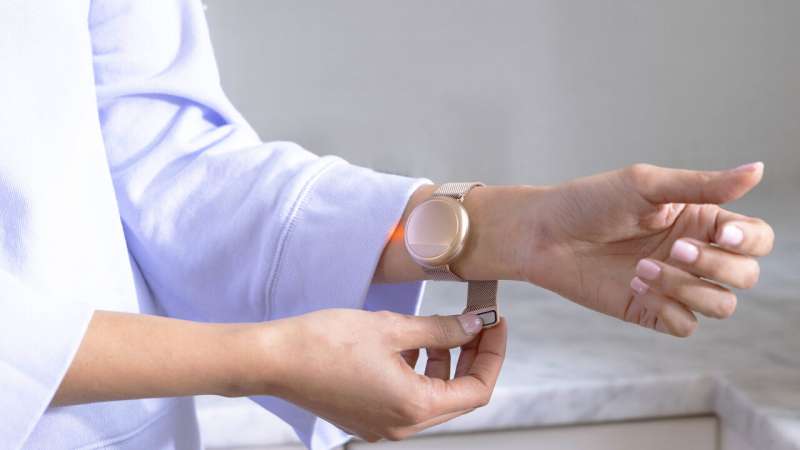This article has been reviewed according to Science X's editorial process and policies. Editors have highlighted the following attributes while ensuring the content's credibility:
fact-checked
trusted source
proofread
Machine-learning algorithm can predict a hot flash before a person perceives it

Researchers at the University of Massachusetts Amherst's Institute for Applied Life Sciences (IALS) and Embr Labs have created a machine-learning algorithm to predict a hot flash before a person perceives it.
When combined with Embr Labs' patented wearable device, Embr Wave, immediate cooling is delivered to mitigate or fully alleviate the event. This first-of-its-kind predictive algorithm is the result of machine learning being applied to the largest data set of digital biomarkers for hot flashes ever collected, which was generated by researchers at UMass Amherst's Center for Human Health and Performance.
"Hot flashes occur in 75% of women and can persist for up to a decade," says Matt Smith, co-founder and CTO of Embr Labs. "We are proud to be developing effective tools for menopause, which has lacked new solutions for too long. By delivering automatic cooling for hot flash relief, we are realizing the holy grail for natural hot flash management."
Unlike previous attempts to combat hot flashes, this is a non-pharmaceutical approach. The current generation of the Embr Wave is worn on the inside of the wearer's wrist and heats or cools at the touch of a button to elicit a brain and body response that can help with resolving hot flashes, improving sleep and relieving stress. The new predictive sensor technology will be commercialized in an upcoming generation of Embr Wave.
"Seeking immediate cooling relief is a person's natural reaction when they are having a hot flash," Smith says. "We now have the know-how and technology to bring this solution into the 21st century: personalized and automatic hot flash management from a small, AI-powered, wearable device."
"This technology is fundamentally different from most other wearable health technologies, e.g. activity trackers," says Mike Busa, director of the IALS Center for Human Health and Performance. "This concept of automatic intervention based on real-time physiological symptoms is relatively unexplored. What has dominated the landscape up to this point is only tracking—letting you know the status of something or letting a care team know that a certain phenomenon has occurred. That technology most certainly has its strengths, but a major limitation is that it does not provide real-time, automated intervention to the person who is dealing with impactful symptoms."
Instead, Busa describes the new system as a "reactive digital drug" for hot flash symptoms. "The solution is not quite so simple as hot plus cold equals neutral," he explains. "In this case, we leverage early physiological changes that precede a person's perception of an oncoming hot flash and provide early relief that aims to automatically deploy an intervention tailored to minimize the disturbance of the hot flash symptoms."
It all happens in real-time. "The device is communicating the data to servers and back to the device in a fraction of a second. That's the power of data and cloud computing combined with the immediate cooling made possible by Embr Labs' thermal technology," Busa says.
Embr Labs was recently awarded a patent for the utilization of biomarkers to activate cooling for hot flashes, and an additional patent has been filed for features powering the corresponding predictive algorithms. A manuscript is in preparation that will benchmark the performance of the predictive algorithms and reveal the science behind hot flash prediction.
This is the second collaboration between Embr Labs and UMass Amherst. Previously, Rebecca Spencer from the Sleep Monitoring Core at IALS and Department of Psychology conducted a pilot study and the results were presented at the 2022 North American Menopause Society. That study found that use of the Embr Wave was associated with improved sleep and reduction in self-reported frequency and intensity of hot flashes and improvement in the impact of stress.

















